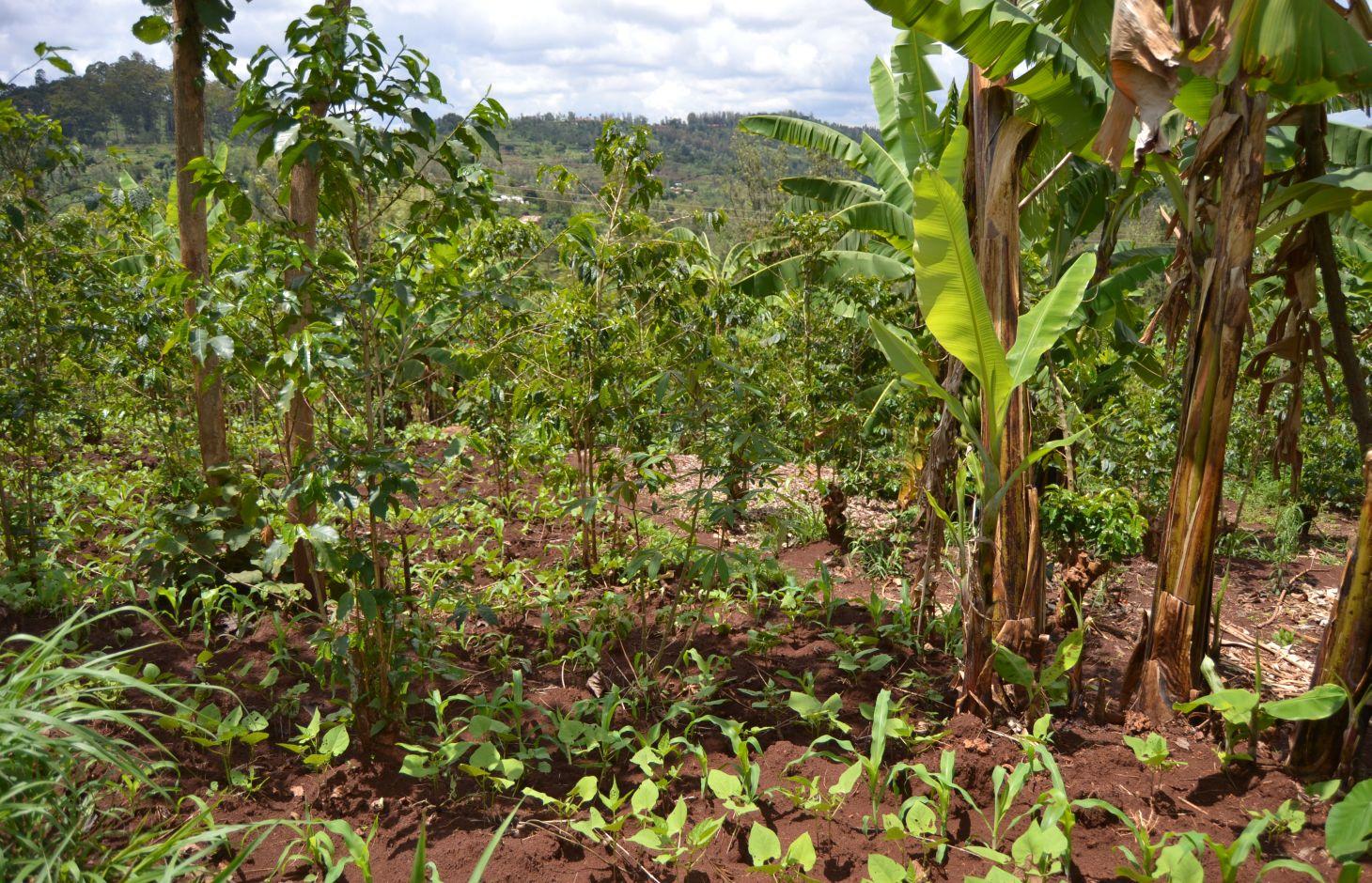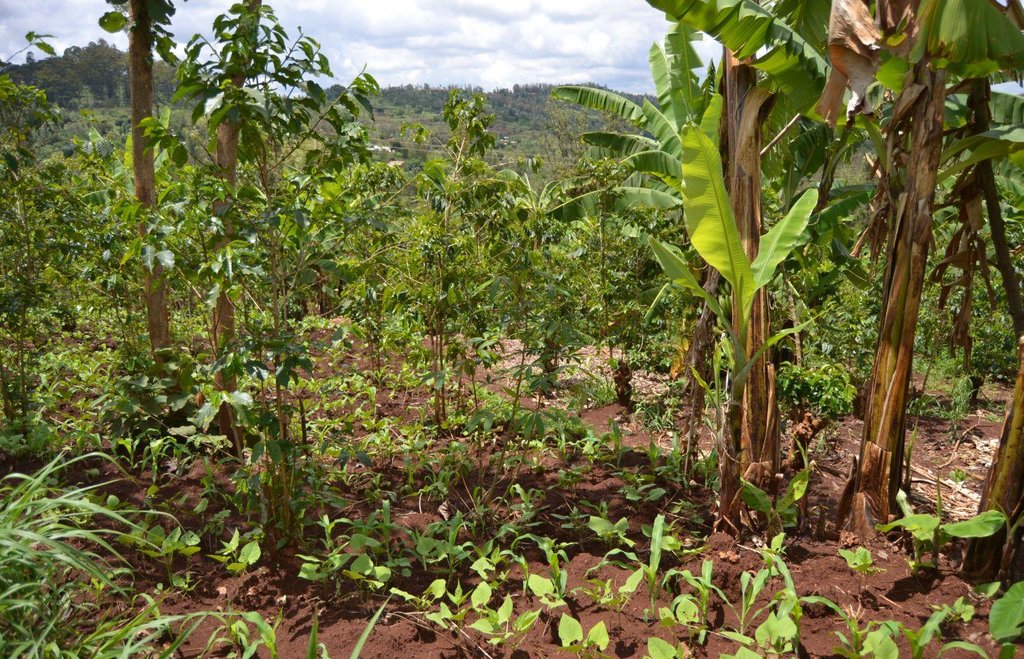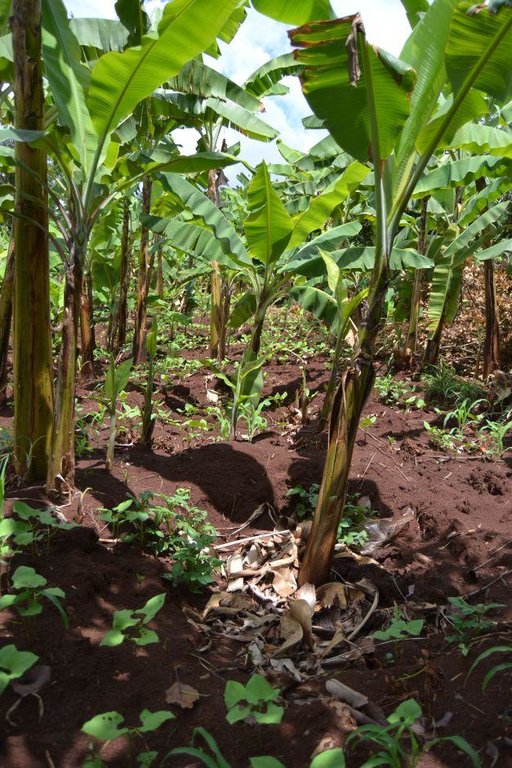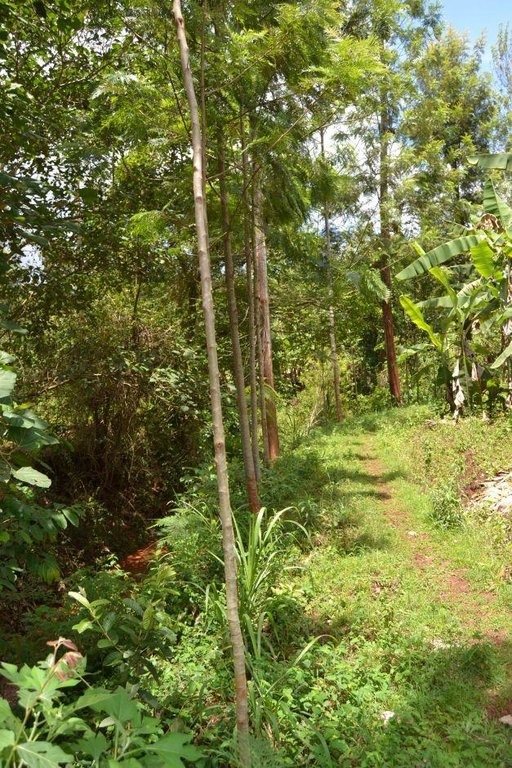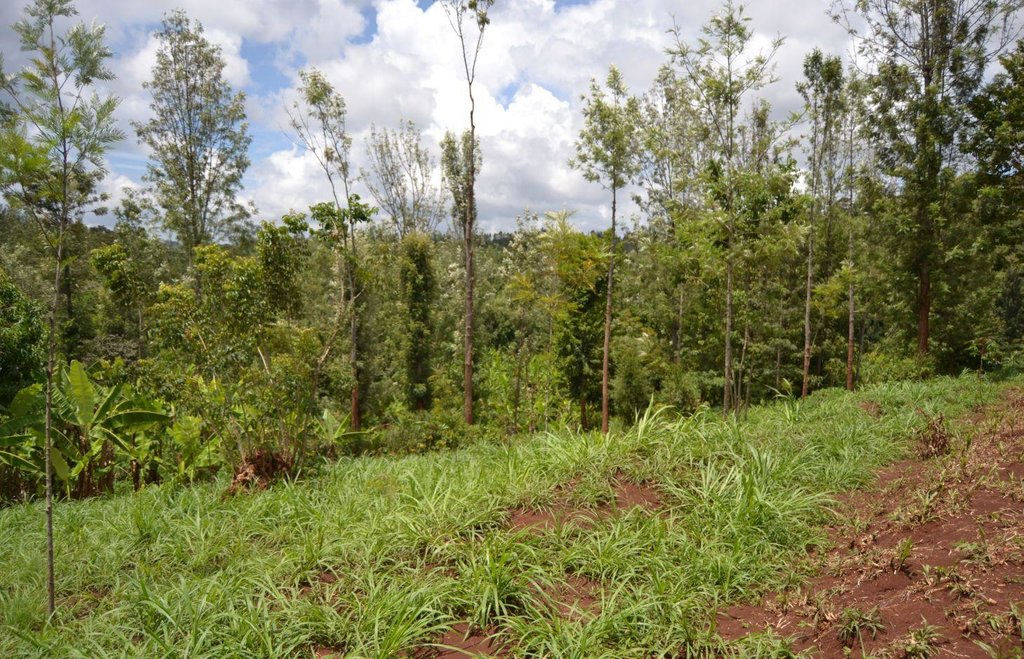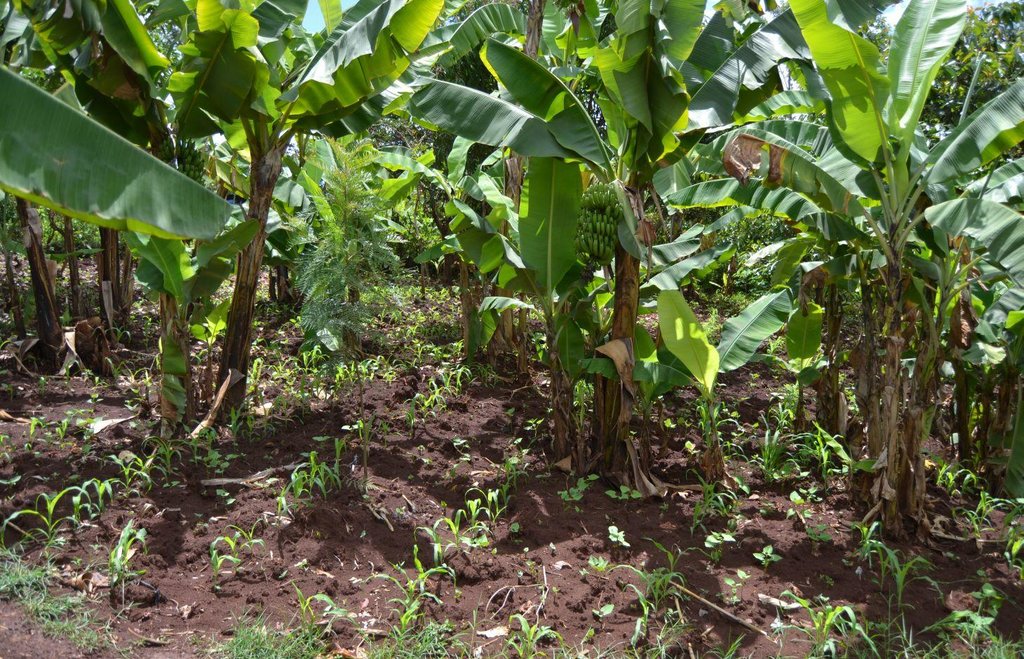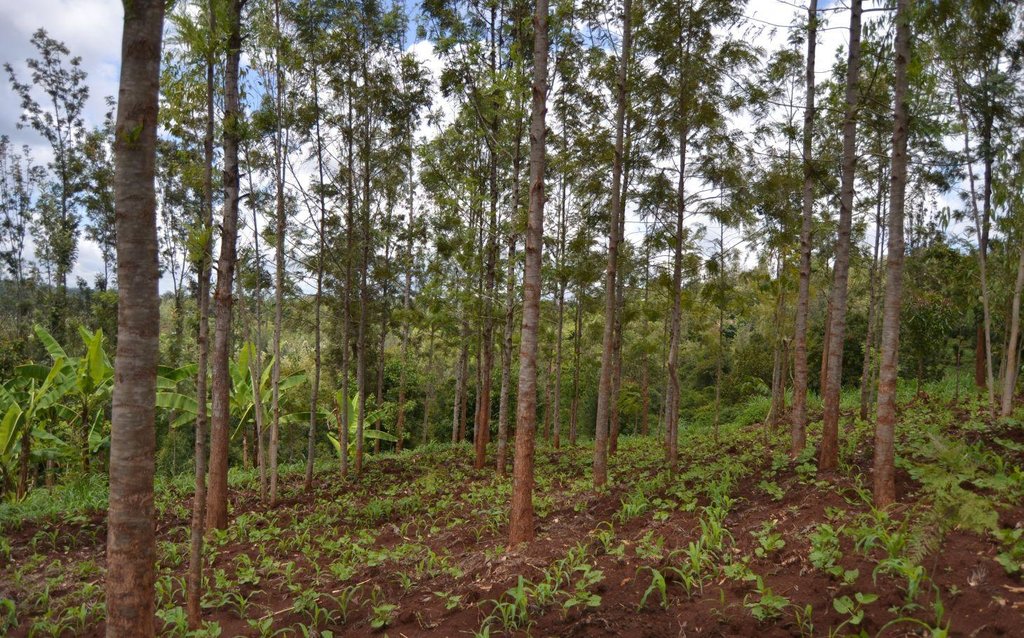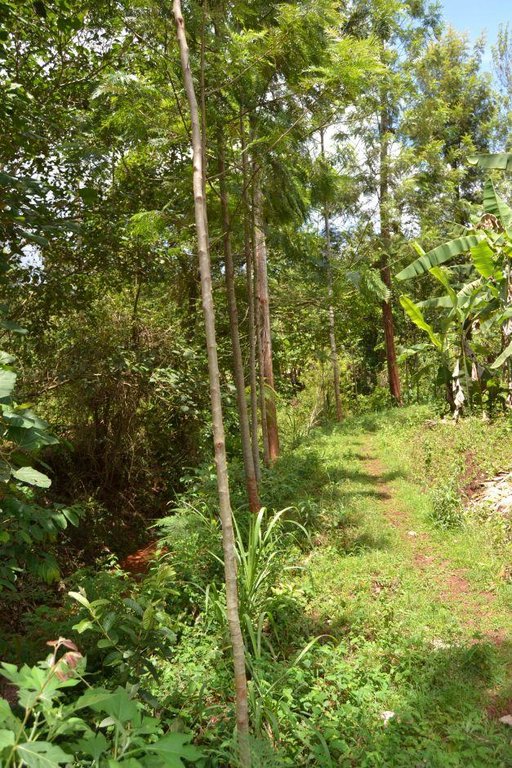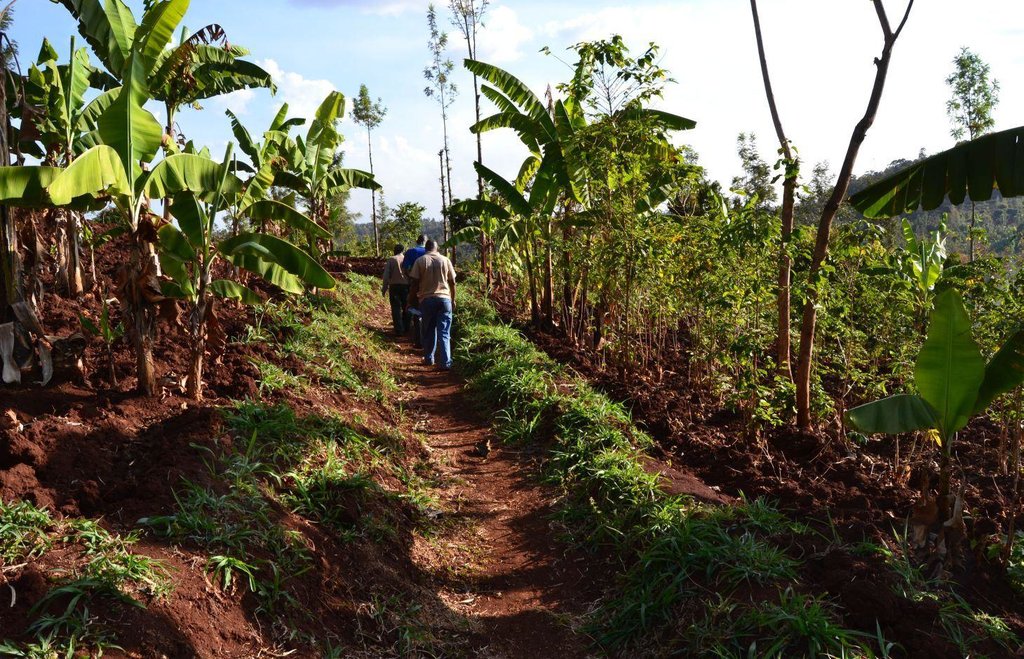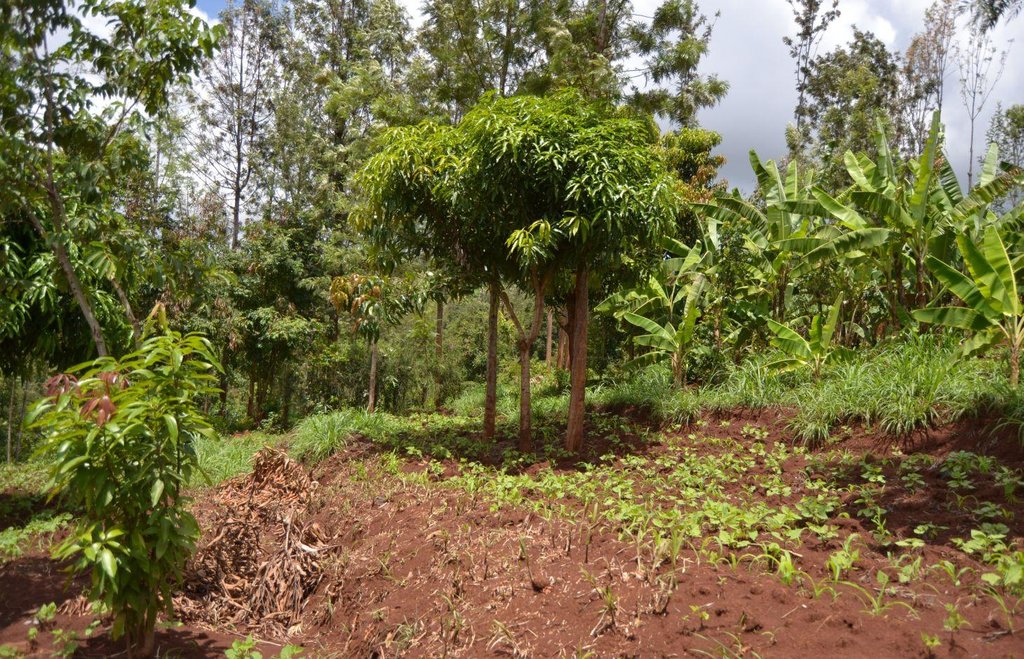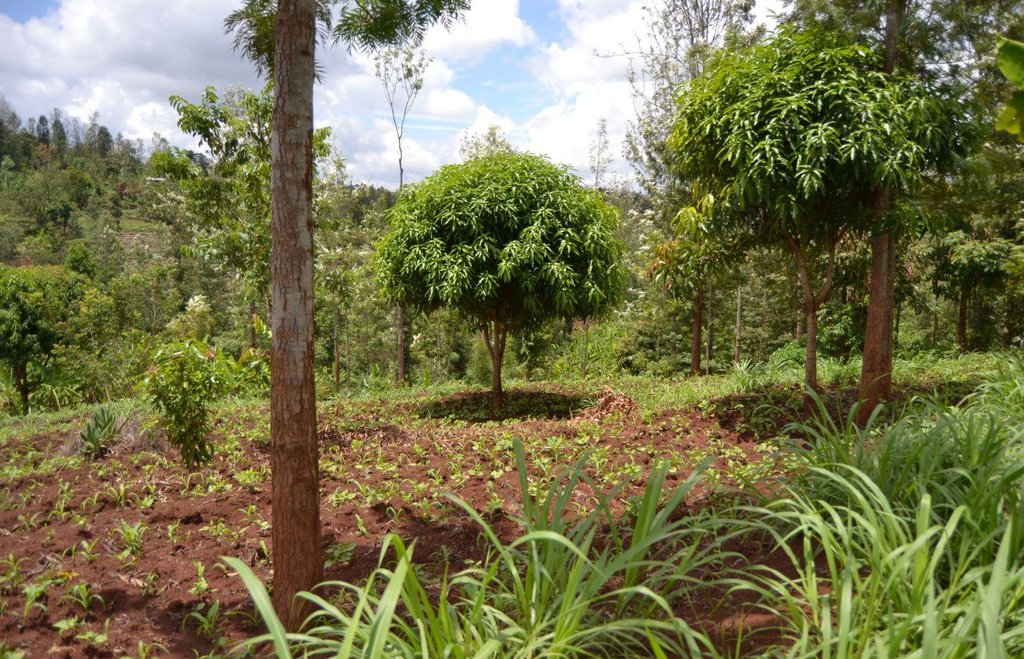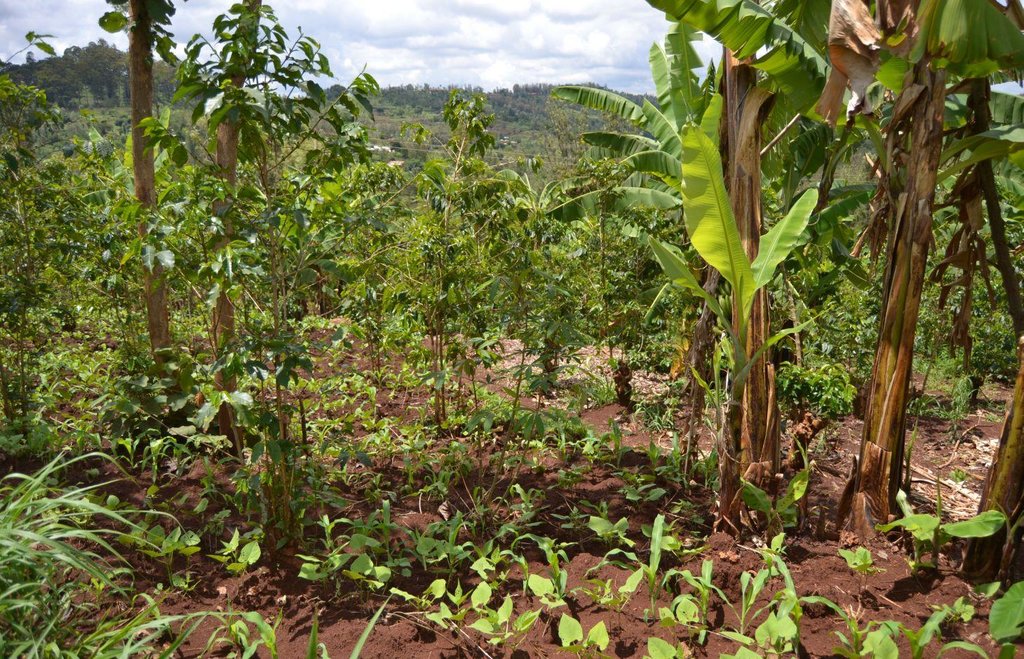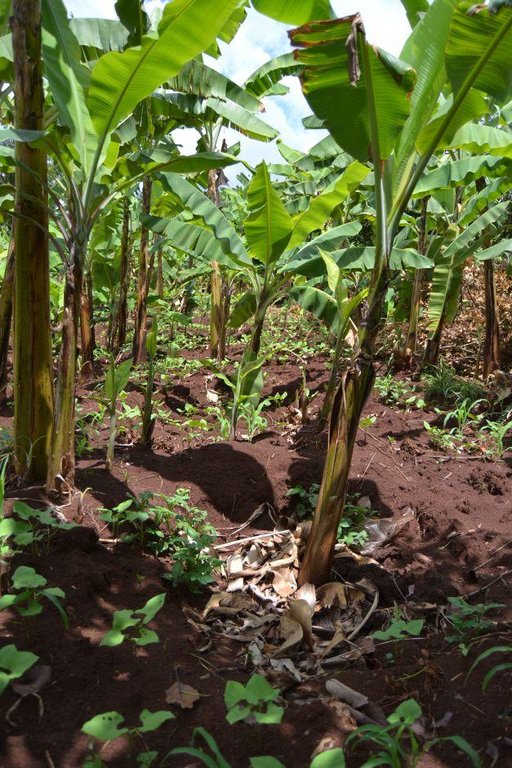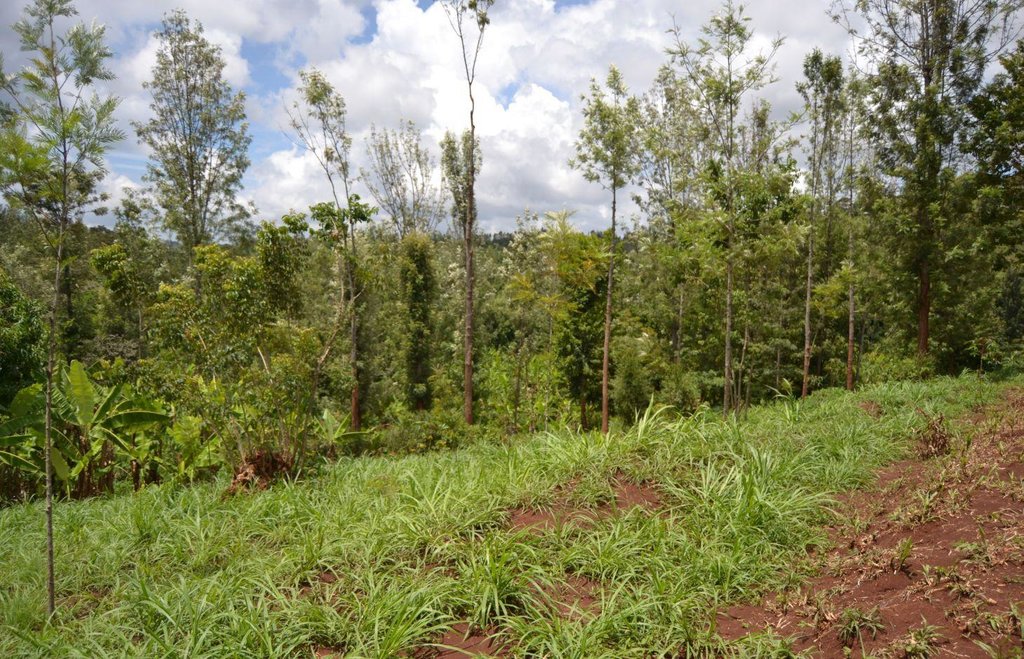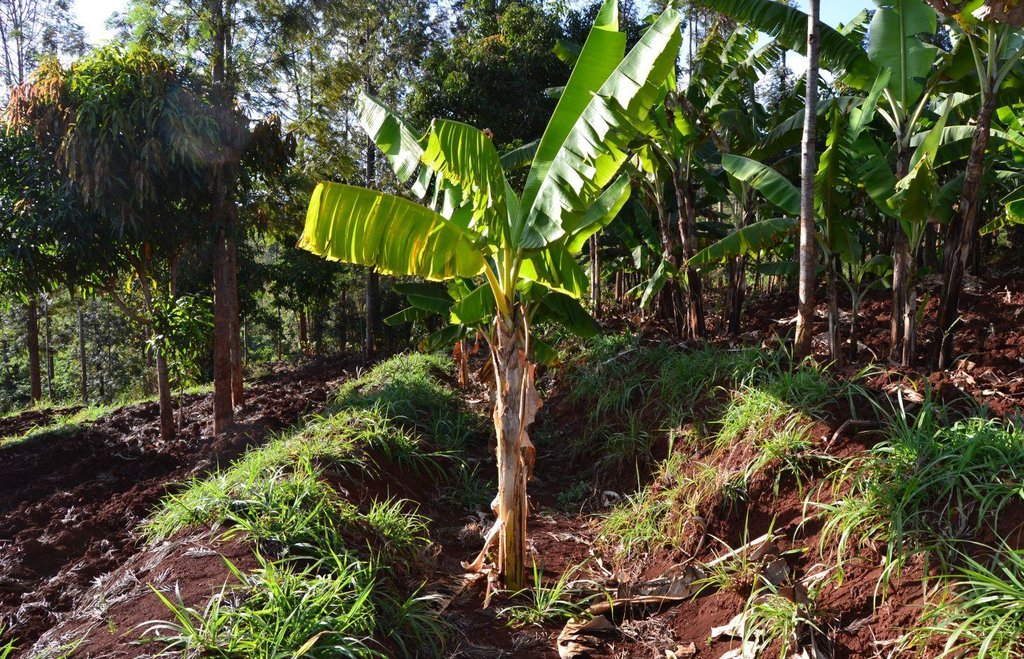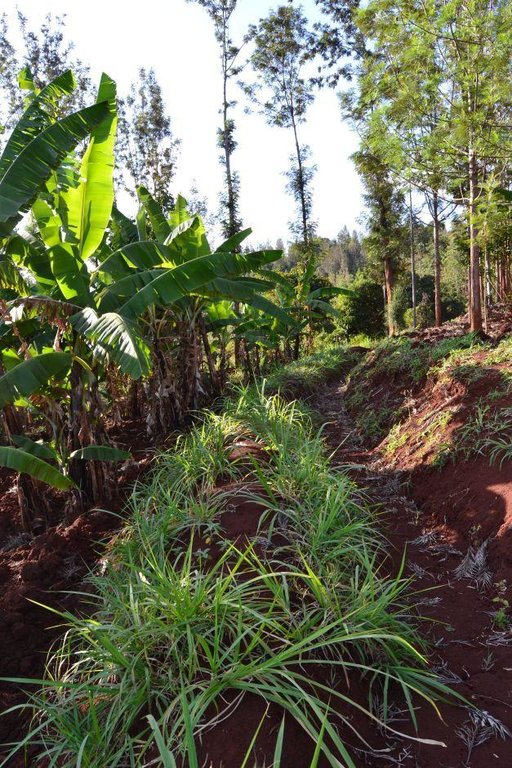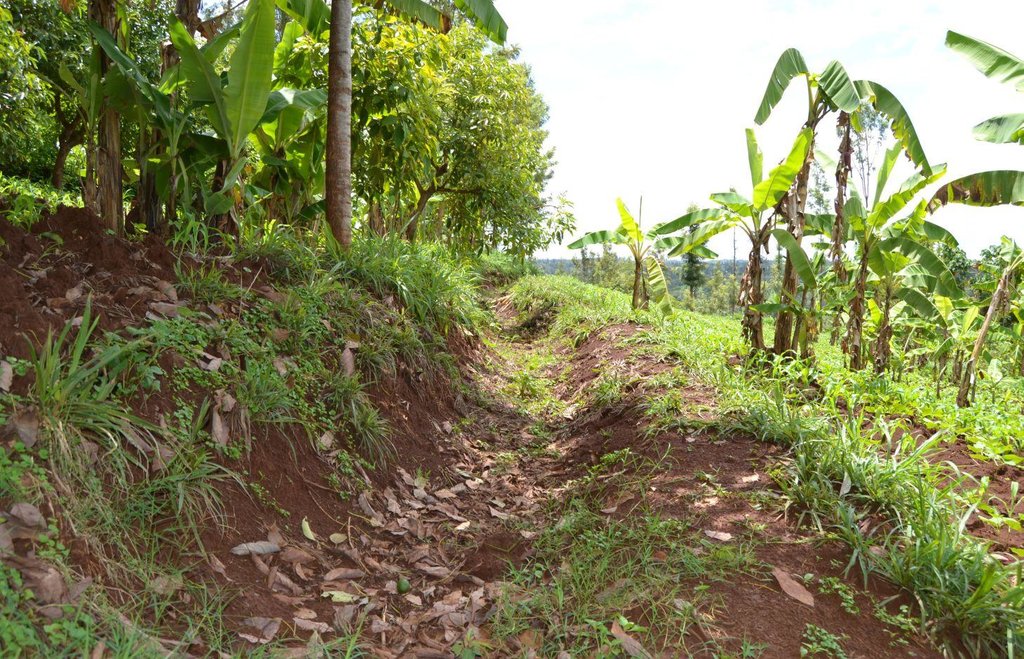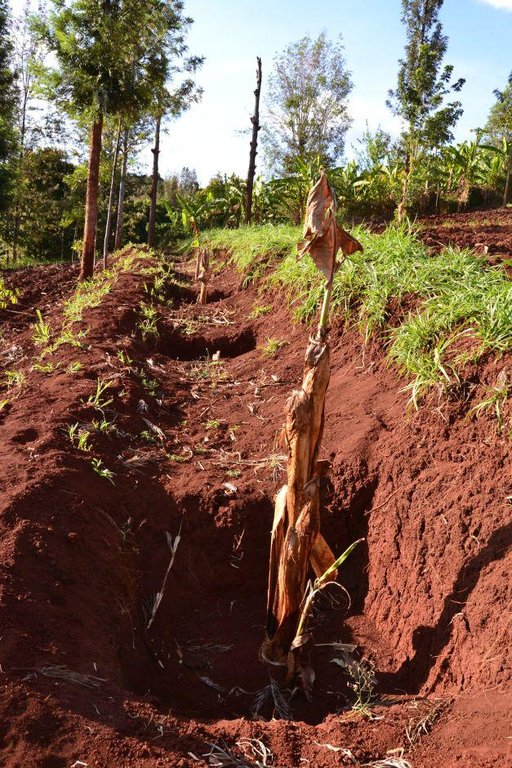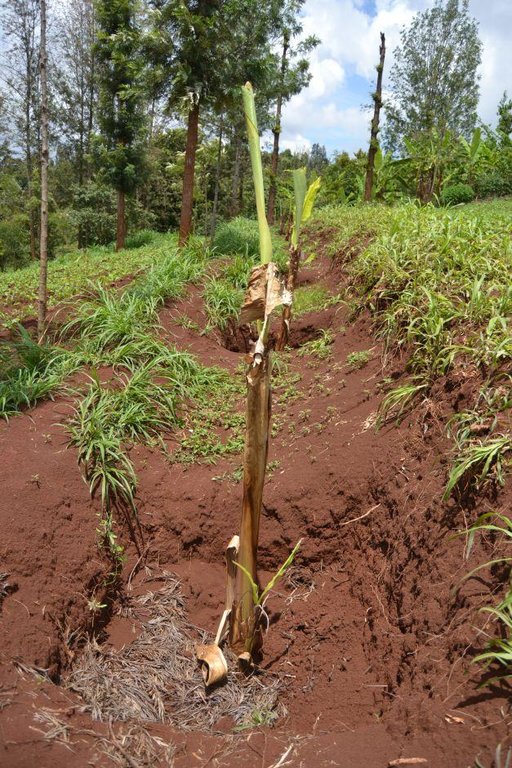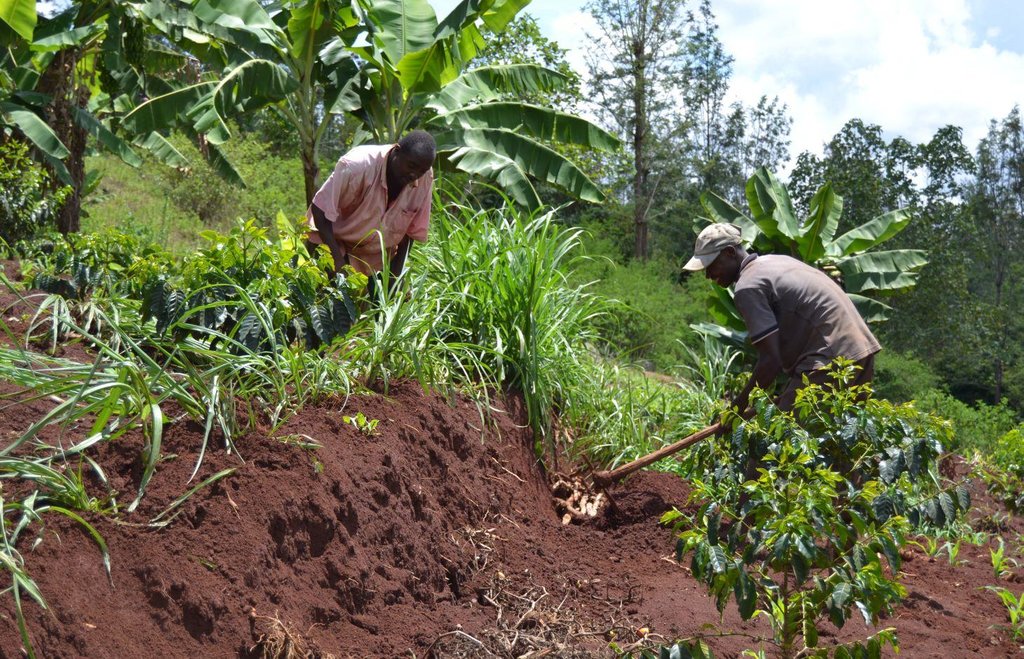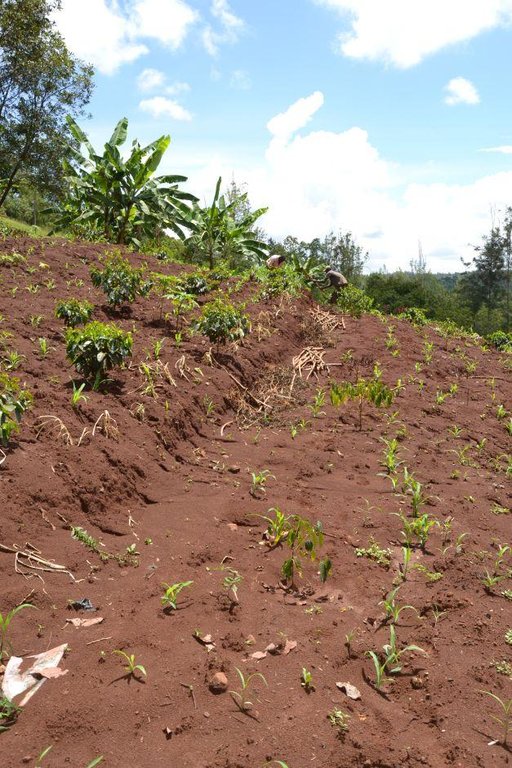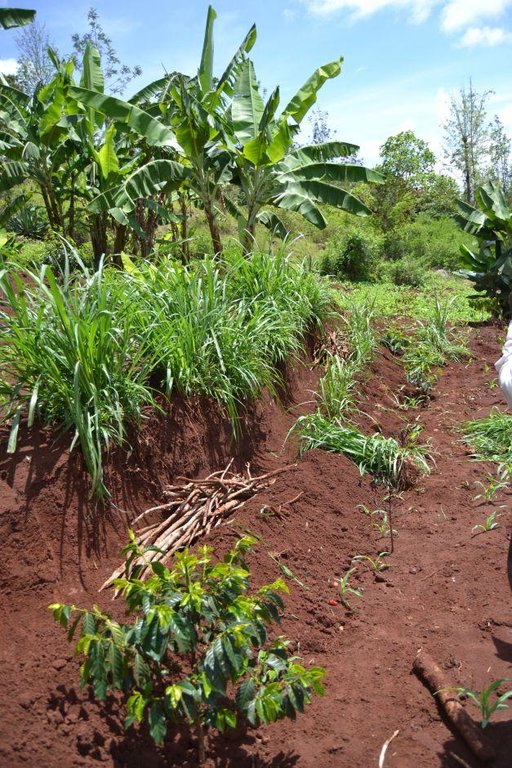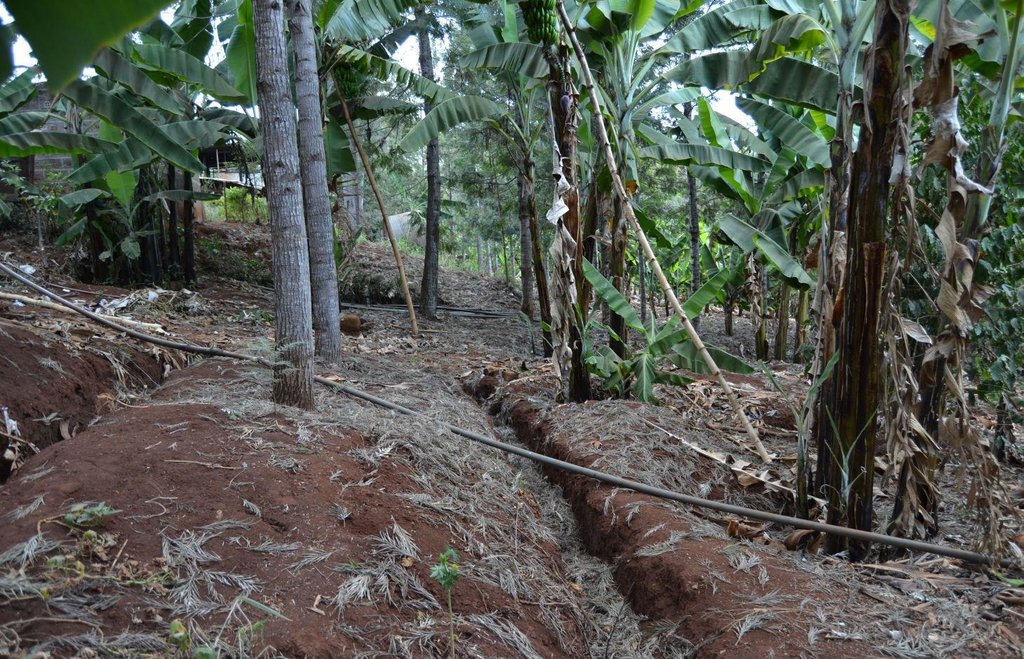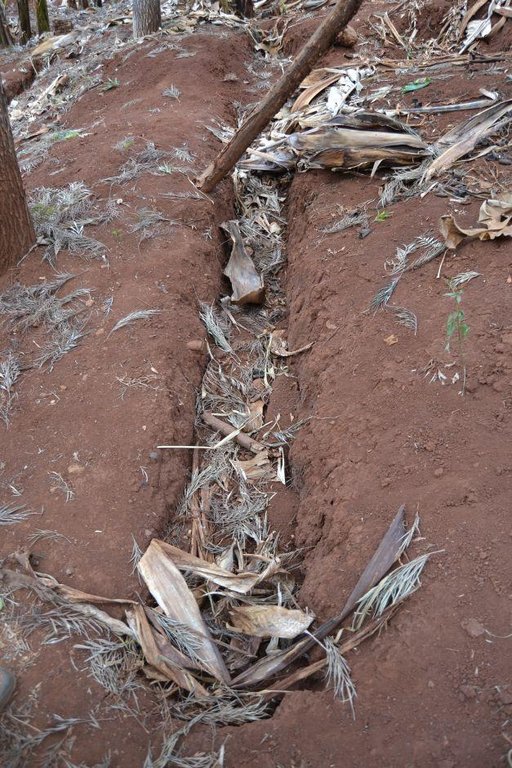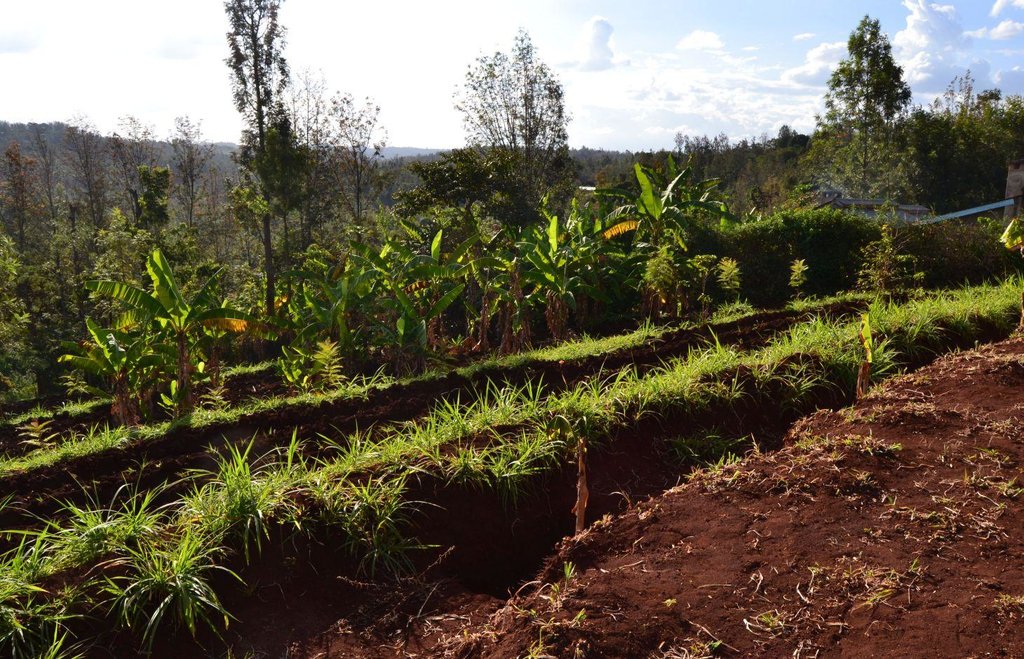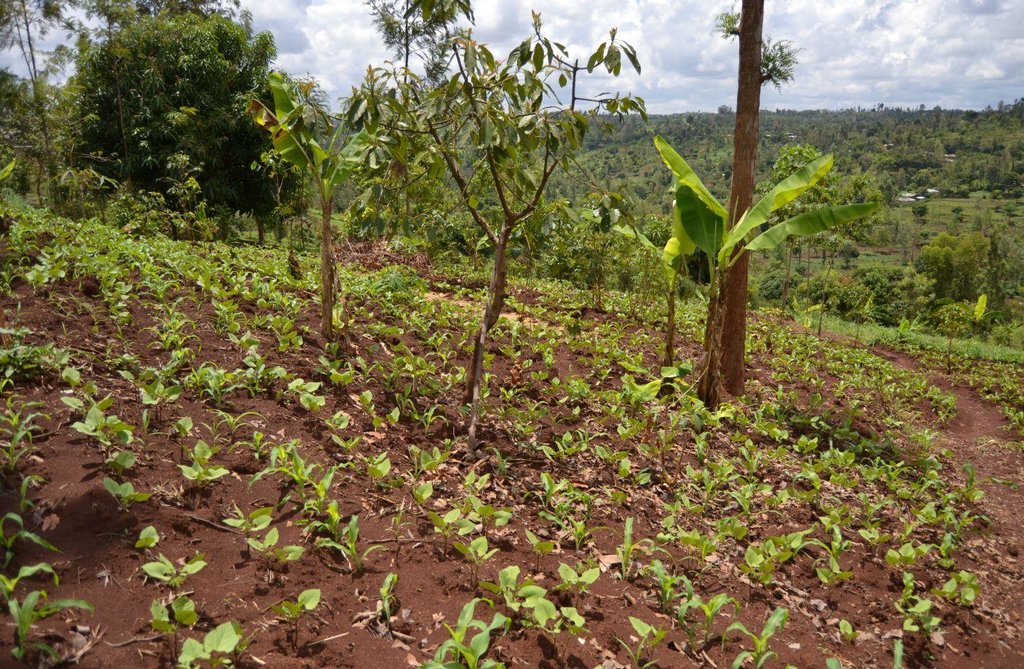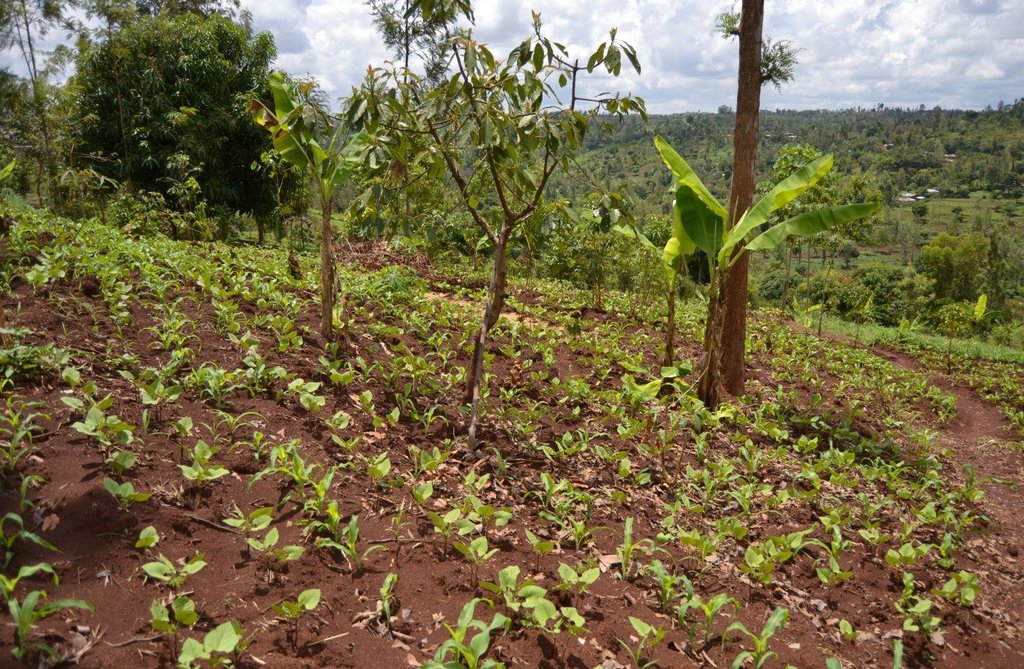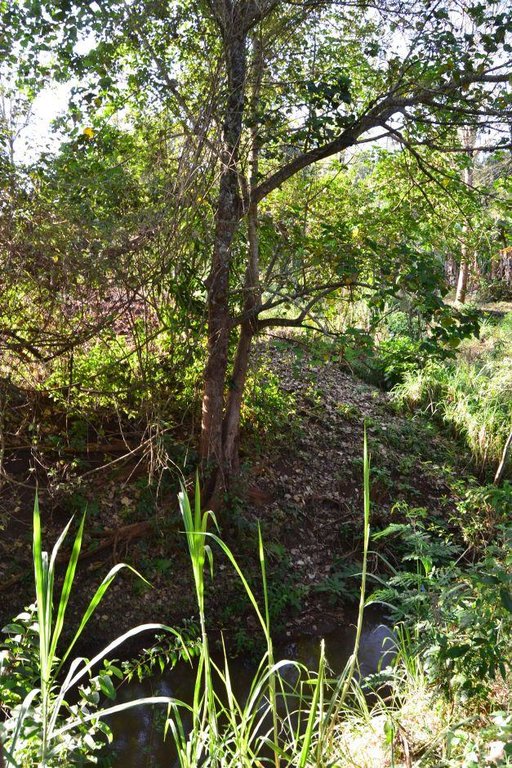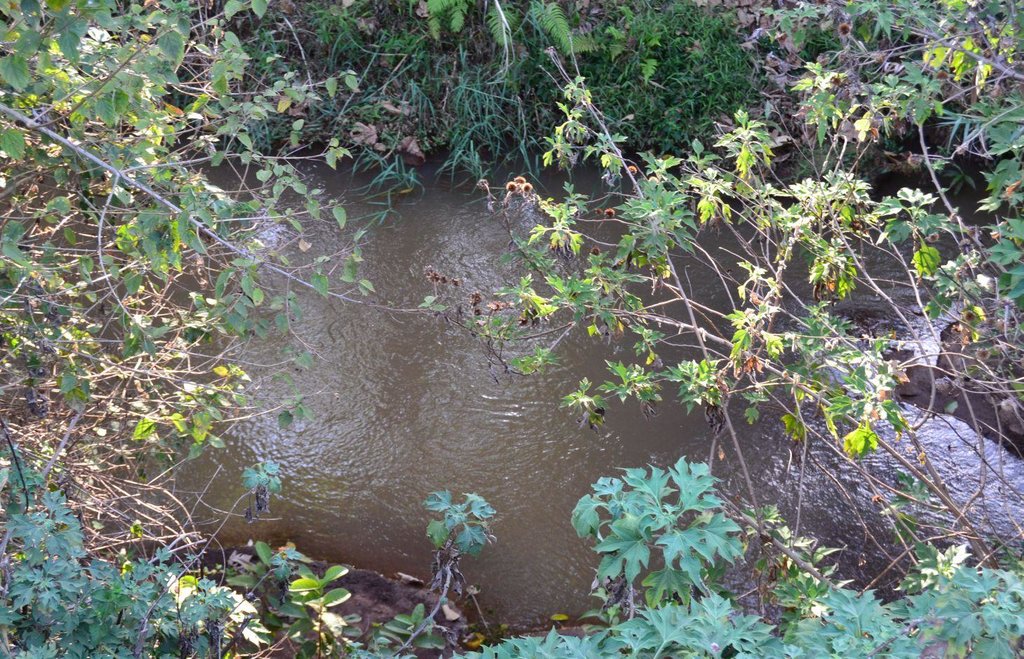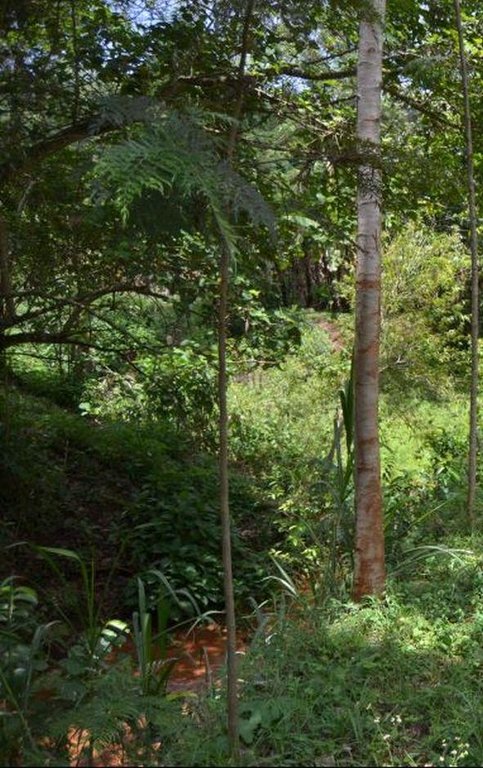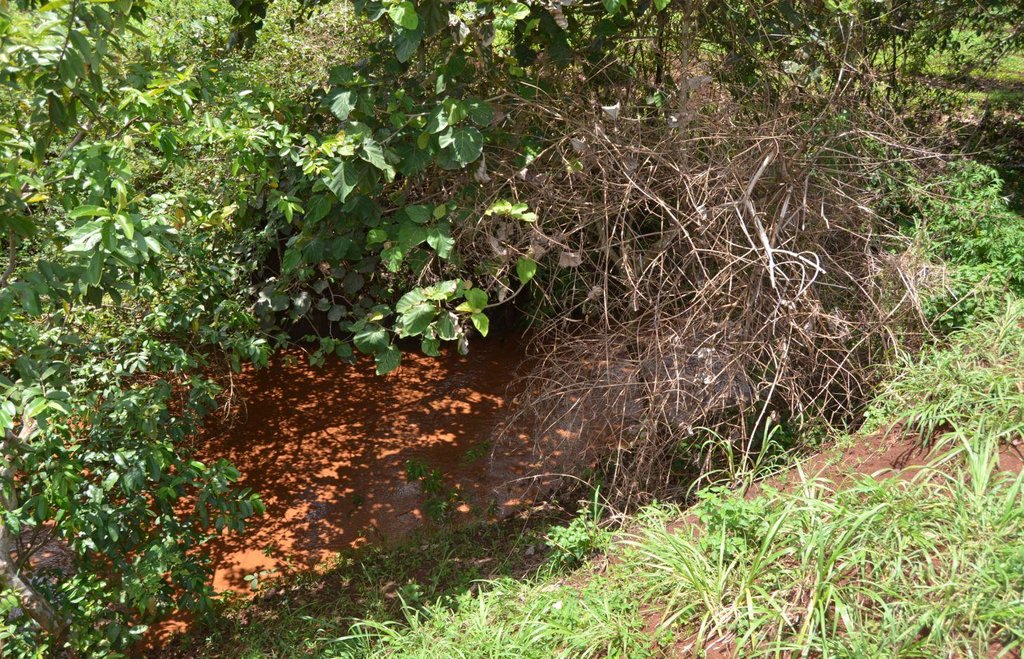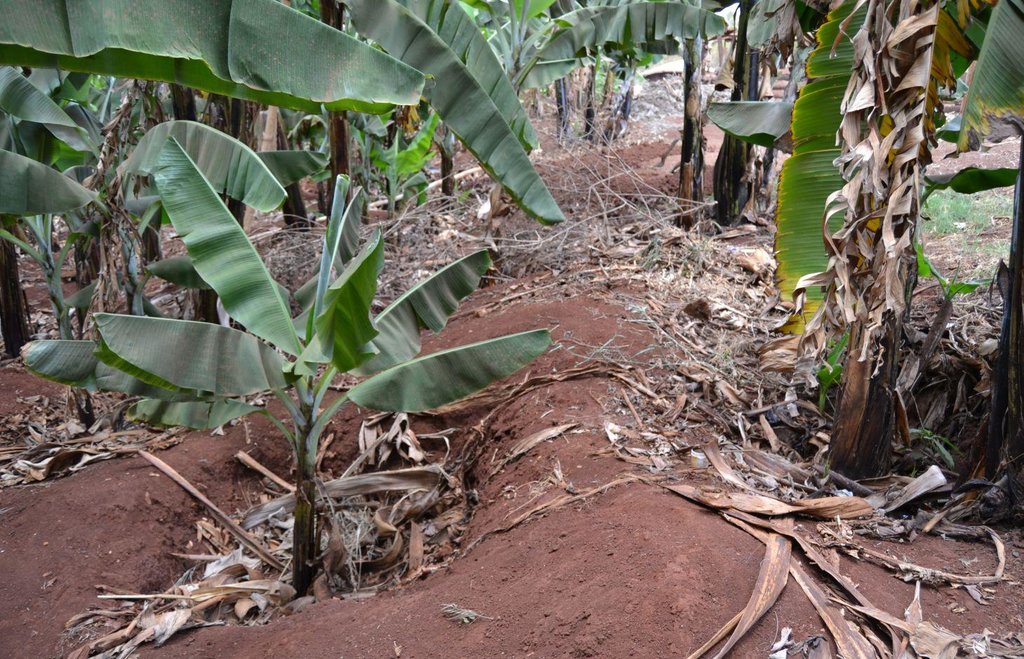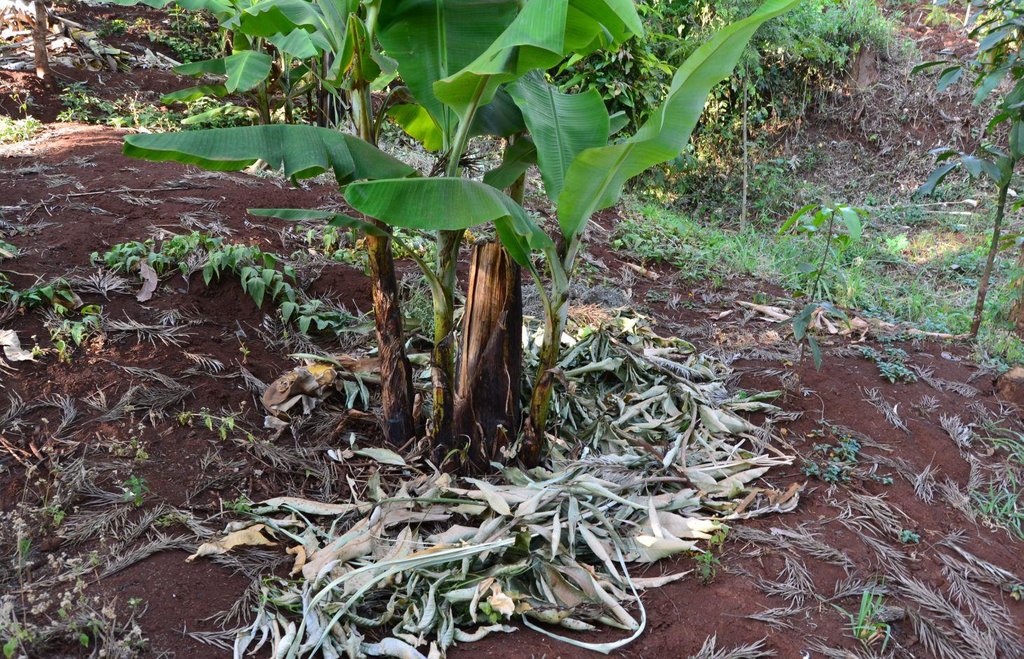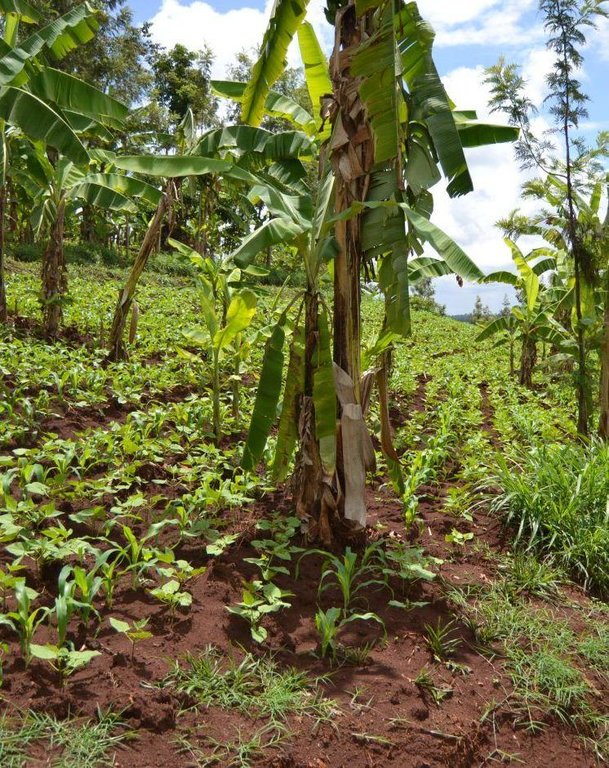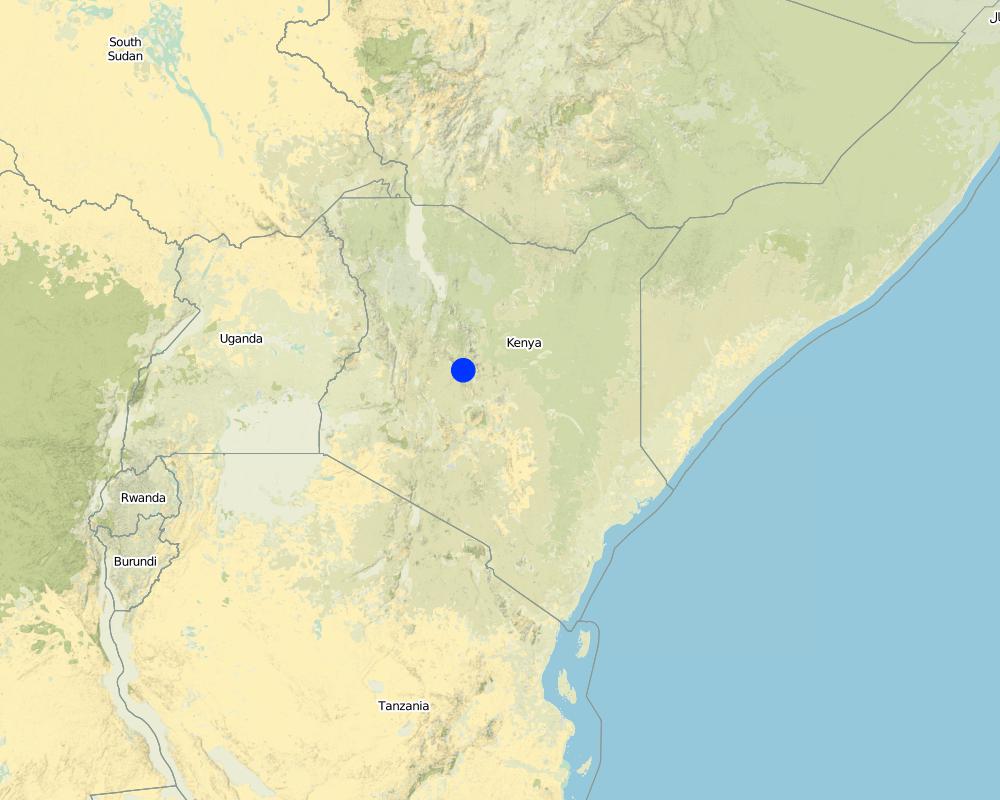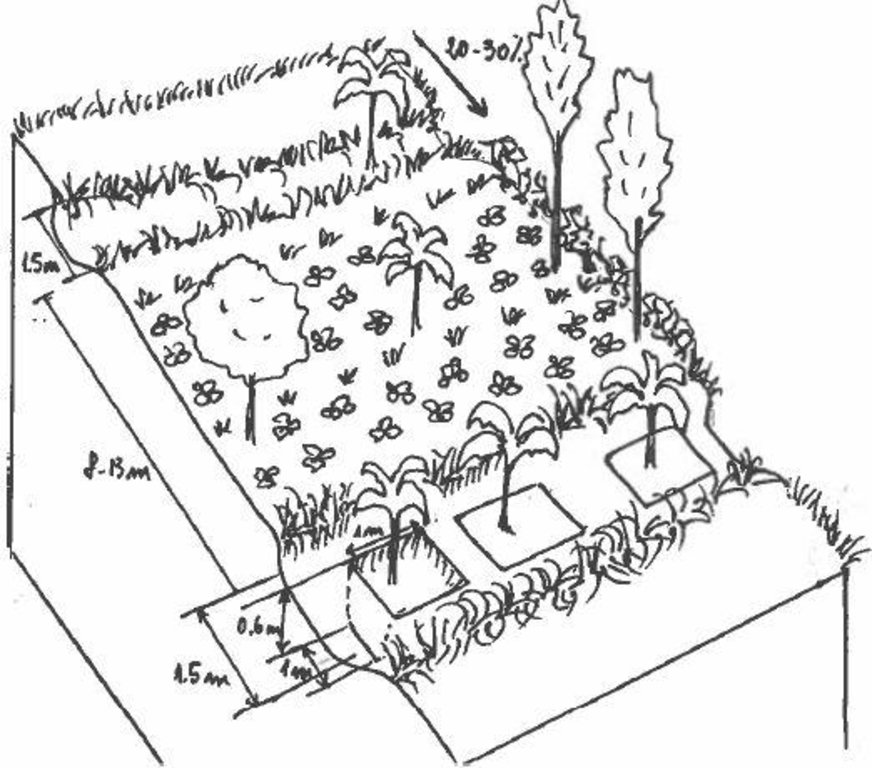Agroforestry land use in bench terraces with cut-off and infiltration ditches and Napier grass strips. [เคนยา]
- ผู้สร้างสรรค์:
- การอัพเดท:
- ผู้รวบรวม: Laura D'Aietti
- ผู้เรียบเรียง: –
- ผู้ตรวจสอบ: Alexandra Gavilano, Fabian Ottiger
technologies_1159 - เคนยา
- บทสรุปทั้งหมดในรูปแบบของ PDF
- บทสรุปทั้งหมดในรูปแบบของ PDF เพื่อพิมพ์
- บทสรุปทั้งหมดในรูปหน้าเว็บ
- บทสรุปทั้งหมด (ไม่มีการจัดเรียง)
- Agroforestry land use in bench terraces with cut-off and infiltration ditches and Napier grass strips.: 29 ธันวาคม 2016 (inactive)
- Agroforestry land use in bench terraces with cut-off and infiltration ditches and Napier grass strips.: 5 มิถุนายน 2017 (inactive)
- Agroforestry land use in bench terraces with cut-off and infiltration ditches and Napier grass strips.: 3 พฤษภาคม 2019 (public)
ดูส่วนย่อย
ขยายทั้งหมด ย่อทั้งหมด1. ข้อมูลทั่วไป
1.2 รายละเอียดที่ติดต่อได้ของผู้รวบรวมและองค์กรที่เกี่ยวข้องในการประเมินและการจัดเตรียมทำเอกสารของเทคโนโลยี
วิทยากรหลัก
ผู้เชี่ยวชาญ SLM:
F. K. Nyamu Jospeh
WRUA Sabasaba
เคนยา
ชื่อขององค์กรซึ่งอำนวยความสะดวกในการทำเอกสารหรือการประเมินเทคโนโลยี (ถ้าเกี่ยวข้อง)
FAO Food and Agriculture Organization (FAO Food and Agriculture Organization) - อิตาลี1.3 เงื่อนไขการใช้ข้อมูลที่ได้บันทึกผ่านทาง WOCAT
ผู้รวบรวมและวิทยากรหลักยอมรับเงื่อนไขเกี่ยวกับการใช้ข้อมูลที่ถูกบันทึกผ่านทาง WOCAT:
ใช่
2. การอธิบายลักษณะของเทคโนโลยี SLM
2.1 การอธิบายแบบสั้น ๆ ของเทคโนโลยี
คำจำกัดความของเทคโนโลยี:
A combination of agricultural (e.g. intercropping, mulching, minimum tillage), vegetative (e.g. Napier grass strips, trees planting) and structural (e.g. ditches, bench terracing) measures which aim to maximise the overall yield in a sustainable manner (e.g. reduction of soil erosion and increasing the soil quality).
2.2 การอธิบายแบบละเอียดของเทคโนโลยี
คำอธิบาย:
The land of the farmer is of 3 acres: 2 acres to plant maize (Zea mays) intercropped with beans (Phaseolus vulgaris) in combination with several trees species: Mangoes, Avocadoes, Bananas, Grevillea and Makadamia and half acre for coffee plantation with Bananas and half with Napier grass production for fodder (to feed cows). To increase and fasten the grass growth, manure is applied twice a year, before the rainy season (around February and September), while mulching is practiced under Banana trees every season. Minimum tillage is applied to reduce soil disturbance and to increase water use efficiency by minimizing direct evaporation, increasing infiltration and water recharge (Liniger, 1991) especially during dry seasons, which results in better crop yields.
For timber production Grevillea trees are planted scattered overall the land and on the edge of the river for demarcation (environmental role in stabilizing the soil against erosive forces).
Concerning the structural measures, the farmer constructed has built 14 bench terraces, six of them were designed to plant cash crops (coffee); each terrace is characterized by a ditch to cut off the drainage and collect water and nutrients; they are also used as paths to facilitate transportation and farm operations. Ditches are both drainage and infiltration types and are excavated along the contour.
Purpose of the Technology: Beans and maize are cultivated for home consumption but partially (about 20%-4 bags of maize and half bag of beans) also for commercial purposes. Coffee is harvested twice a year, with a production of about 500 kg per season; the coffee is sold at 45 Kenyan Shillings (KSh) per kg (SL-28-arabica varieties). Indeed, the farmer is interested in cultivating the certified and improved variety called Ruiru 11 which is generally disease resistant, easy to maintain (less expensive) with a modest risk of pests (according to the farmer). Grevillea timber is sold twice a year, only trees of 1.5 feet in diameter (about 45 cm), at about 80 KSh per feet. Beside the commercial role of Grevillea, when sufficiently grown these trees lead to a reduction of the wind speed, protect the intercrops and provide mulching material to be used over banana trees. The deep roots of mature Grevillea are not in competition with the crops for soil and water, instead they enhance infiltration (Otengi, 2007). Makadamia will be used to produce cooking oil, while bananas, avocados and mangoes are fruits collected for the local markets. Napier grass is cultivated to stabilize the ditches and for fodder production.
Establishment / maintenance activities and inputs: There is a high initial input (mainly labour) needed to create ditches and terraces and for planting crops is required. The vegetative and structural measures require a labour intensive management during the year, for example maintenance is necessary after each rainy season to repair ditches and to rebuild terraces (e.g. because of the accumulation of soil and organic matter in the pits and ditches). Concerning Napier grass, labour is employed regularly for weed control, to cut grass for fodder and every three seasons to replace and replant the grass because it becomes less productive. Concerning trees, in the Agroforestry systems, canopies of Mango and Avocado trees shade the soil reducing evapotranspiration and therefore improving soil water storage. On the other hand, regular pruning is needed when the shadow effect obstructs photosynthesis and therefore growth of the crops planted below (maize and beans). Pruning of branches is carried out also for firewood. Furthermore, a common practice is Grevillea root pruning to conserve soil moisture (Otengi, 2007) and to reduce competition for nutrients during the growing season. Indeed, the farmer explained how superficial roots may interfere with the Banana root system and to cut them he has created small trenches. Harvesting is carried out twice during the year for both cereals and coffee.
Natural / human environment: The area is characterized by rolling to hilly slopes, therefore it is exposed to erosion and land degradation. The combination of trees with mixed crops is adopted to maximise productivity and at the same time to prevent degradation by increasing the vegetative cover.
2.3 รูปภาพของเทคโนโลยี
2.5 ประเทศภูมิภาค หรือสถานที่ตั้งที่เทคโนโลยีได้นำไปใช้และได้รับการครอบคลุมโดยการประเมินนี้
ประเทศ:
เคนยา
ภูมิภาค/รัฐ/จังหวัด:
Kenya
ข้อมูลจำเพาะเพิ่มเติมของสถานที่ตั้ง :
Muthithi location-Kagurumo sublocation-Gatwamikwa village
ระบุการกระจายตัวของเทคโนโลยี:
- กระจายไปอย่างสม่ำเสมอในพื้นที่
If the Technology is evenly spread over an area, specify area covered (in km2):
0.0121
If precise area is not known, indicate approximate area covered:
- < 0.1 ตร.กม.(10 เฮกตาร์)
แสดงความคิดเห็น:
About 1.21 ha (3 acres).
The area accounts for the land owned and cultivated by the farmer. According to the interviewee from the Ministry of Agriculture, on average farmers in Saba Saba sub-catchment own 1 acre of land (Elemans, 2011).
Map
×2.6 วันที่การดำเนินการ
ถ้าไม่รู้ปีที่แน่นอน ให้ระบุวันที่โดยประมาณ:
- มากกว่า 50 ปี (แบบดั้งเดิม)
2.7 คำแนะนำของเทคโนโลยี
ให้ระบุว่าเทคโนโลยีถูกแนะนำเข้ามาอย่างไร:
- เป็นส่วนหนึ่งของระบบแบบดั้งเดิมที่ทำก้นอยู่ (> 50 ปี)
ความคิดเห็น (ประเภทของโครงการ เป็นต้น) :
The technology has been started by the father of the farmer about 70 years ago. His initiative has been developed and improved over time thanks also to the support of the MoA extension officers.
3. การจัดประเภทของเทคโนโลยี SLM
3.2 ประเภทของการใช้ที่ดินในปัจจุบันที่ได้นำเทคโนโลยีไปใช้
Land use mixed within the same land unit:
ใช่
Specify mixed land use (crops/ grazing/ trees):
- การปลูกพืชร่วมกับปศุสัตว์และการทำป่าไม้ (Agro-silvopastoralism)

พื้นที่ปลูกพืช
- การปลูกพืชล้มลุกอายุปีเดียว
- การปลูกพืชยืนต้นที่ไม่มีเนื้อไม้
- การปลูกไม้ยืนต้น ไม้พุ่ม
Annual cropping - Specify crops:
- cereals - maize
- fodder crops - grasses
- legumes and pulses - beans
Perennial (non-woody) cropping - Specify crops:
- banana/plantain/abaca
Tree and shrub cropping - Specify crops:
- avocado
- mango, mangosteen, guava
- tree nuts (brazil nuts, pistachio, walnuts, almonds, etc.)
- coffee
จำนวนของฤดูเพาะปลูกต่อปี:
- 2
ระบุ:
Longest growing period in days: 122Longest growing period from month to month: from about March to JuneSecond longest growing period in days: 61Second longest growing period from month to month: from about October to November
Is intercropping practiced?
ใช่

ทุ่งหญ้าเลี้ยงสัตว์
ทุ่งหญ้าเลี้ยงสัตว์ที่มีการจัดการแบบเข้มข้นหรือการผลิตอาหารสัตว์:
- ตัดแล้วขนไป / ไม่มีการปล่อยแทะเล็มเอง (Cut-and-carry / zero grazing)
- cattle

ป่า/พื้นที่ทำไม้
Type of tree:
- Grevillea robusta
แสดงความคิดเห็น:
Trees/ shrubs species: Grevillea, Coffee
Fruit trees / shrubs species: Persea americana (avocado), Musa sapientum (banana/plantain), Mangifera indica (Mango), Macadamia tetraphylla (nuts)
Grass species: Pennisetum pyramidalis (Napier grass or elephant grass)
Major land use problems (compiler’s opinion): Soil erosion and nutrient leaching which could drain into the river (Fig. 17).
Major land use problems (land users’ perception): The most important limiting factor to the crop and fodder production remains water: not only related to the weather conditions (e.g. shorter and delayed rainy seasons) but due to the lack of a proper irrigation systems, to minimize the water losses and time. Furthermore, soil has been considered 'not good', because does not hold enough water due to the slope of the land.
Livestock density: < 1 LU/km2
Fodder for 2 cows, from Napier grass
3.3 Has land use changed due to the implementation of the Technology?
Has land use changed due to the implementation of the Technology?
- Yes (Please fill out the questions below with regard to the land use before implementation of the Technology)
Land use mixed within the same land unit:
ใช่
Specify mixed land use (crops/ grazing/ trees):
- วนเกษตร (Agroforestry)

พื้นที่ปลูกพืช
- การปลูกพืชล้มลุกอายุปีเดียว

ป่า/พื้นที่ทำไม้
3.4 การใช้น้ำ
การใช้น้ำของที่ดินที่มีการใช้เทคโนโลยีอยู่:
- จากน้ำฝน
3.6 มาตรการ SLM ที่ประกอบกันเป็นเทคโนโลยี

มาตรการจัดการพืช
- A1: พืช/สิ่งปกคลุมดิน
- A2: อินทรียวัตถุในดิน/ความอุดมสมบูรณ์ในดิน
- A3: การรักษาหน้าดิน

มาตรการอนุรักษ์ด้วยวิธีพืช
- V1: ต้นไม้และพุ่มไม้คลุมดิน
- V2: หญ้าและไม้ยืนต้น

มาตรการอนุรักษ์ด้วยโครงสร้าง
- S1: คันดิน
- S4: คูน้ำแนวระดับ หลุม
แสดงความคิดเห็น:
Type of agronomic measures: mulching, legume inter-planting, manure / compost / residues, minimum tillage
Type of vegetative measures: aligned: -graded strips
3.7 รูปแบบหลักของการเสื่อมโทรมของที่ดินที่ได้รับการแก้ไขโดยเทคโนโลยี

การกัดกร่อนของดินโดยน้ำ
- Wt (Loss of topsoil): การสูญเสียดินชั้นบนหรือการกัดกร่อนที่ผิวดิน

การเสื่อมโทรมของดินทางด้านเคมี
- Cn (Fertility decline): ความอุดมสมบูรณ์และปริมาณอินทรียวัตถุในดินถูกทำให้ลดลงไป (ไม่ได้เกิดจากสาเหตุการกัดกร่อน)

การเสื่อมโทรมของน้ำ
- Hp (Decline of surface water quality): การลดลงของคุณภาพน้ำที่ผิวดิน
แสดงความคิดเห็น:
Main causes of degradation: soil management (Poor soil management practices), deforestation / removal of natural vegetation (incl. forest fires) (Poor vegetation cover, mainly herbaceous), disturbance of water cycle (infiltration / runoff) (Land use: cropland), other natural causes (avalanches, volcanic eruptions, mud flows, highly susceptible natural resources, extreme topography, etc.) specify (From gentle to hilly slope)
Secondary causes of degradation: Heavy / extreme rainfall (intensity/amounts) (Especially during wet seasons: March-June and October-November)
3.8 การป้องกัน การลดลง หรือการฟื้นฟูความเสื่อมโทรมของที่ดิน
ระบุเป้าหมายของเทคโนโลยีกับความเสื่อมโทรมของที่ดิน:
- ป้องกันความเสื่อมโทรมของที่ดิน
- ลดความเสื่อมโทรมของดิน
4. ข้อมูลจำเพาะด้านเทคนิค กิจกรรมการนำไปปฏิบัติใช้ ปัจจัยนำเข้า และค่าใช้จ่าย
4.1 แบบแปลนทางเทคนิคของเทคโนโลยี
ข้อมูลจำเพาะด้านเทคนิค (แบบแปลนทางเทคนิคของเทคโนโลยี):
Detailed overview of the Agroforestry system in a bench terrace with infiltration (retention) and cut off (drainage) ditches. Along them, strips of Napier grass on both sides.
Location: Upper Saba saba river. Kagurumo in Muthithi location
Technical knowledge required for land users: moderate
Main technical functions: control of dispersed runoff: retain / trap, control of dispersed runoff: impede / retard, reduction of slope angle, reduction of slope length, improvement of ground cover, increase in organic matter, increase of infiltration, increase / maintain water stored in soil, water harvesting / increase water supply, sediment retention / trapping, sediment harvesting
Secondary technical functions: improvement of topsoil structure (compaction), stabilisation of soil (eg by tree roots against land slides), increase in nutrient availability (supply, recycling,…), improvement of water quality, buffering / filtering water, increase of biomass (quantity)
Mulching
Material/ species: Organic residues around Banana trees
Quantity/ density: undefined
Legume inter-planting
Quantity/ density: 3bags270kg
Manure / compost / residues
Material/ species: Manure from two cows
Quantity/ density: 8 tonnes
Remarks: for 1 year
Aligned: -graded strips
Vegetative material: G : grass
Number of plants per (ha): 400 grass per2lines strip
Vertical interval between rows / strips / blocks (m): few cm
Spacing between rows / strips / blocks (m): 1
Vertical interval within rows / strips / blocks (m): 0.4
Width within rows / strips / blocks (m): 0.6-1
Scattered / dispersed
Vegetative material: T : trees / shrubs, F : fruit trees / shrubs
Number of plants per (ha): about 80
Trees/ shrubs species: Grevillea, Coffee
Fruit trees / shrubs species: Persea americana, Musa sapientum, Mangifera indica, Macadamia tetraphylla
Grass species: Pennisetum pyramidalis (Napier grass or elephant grass)
Slope (which determines the spacing indicated above): 20-25%
If the original slope has changed as a result of the Technology, the slope today is (see figure below): 15%
Gradient along the rows / strips: 5-8%
Diversion ditch/ drainage
Vertical interval between structures (m): 1
Spacing between structures (m): 8-13
Depth of ditches/pits/dams (m): 0.6-1
Retention/infiltration ditch/pit, sediment/sand trap
Vertical interval between structures (m): 1
Spacing between structures (m): 8-13
Depth of ditches/pits/dams (m): 0.6-1
Terrace: forward sloping
Vertical interval between structures (m): 1
Spacing between structures (m): 12-15
Slope (which determines the spacing indicated above): 5-8 (moderate) (Fig.4-7Annex3)%
If the original slope has changed as a result of the Technology, the slope today is: 5%
Lateral gradient along the structure: 25-30%
ผู้เขียน:
D'Aietti Laura
วันที่:
02/11/2012
4.2 ข้อมูลทั่วไปเกี่ยวกับการคำนวณปัจจัยนำเข้าและค่าใช้จ่าย
อื่นๆ หรือสกุลเงินประจำชาติ (ระบุ):
Kenyan Schellings
If relevant, indicate exchange rate from USD to local currency (e.g. 1 USD = 79.9 Brazilian Real): 1 USD =:
85.9
ระบุค่าเฉลี่ยของค่าจ้างในการจ้างแรงงานต่อวัน:
2.00
4.3 กิจกรรมเพื่อการจัดตั้ง
| กิจกรรม | Timing (season) | |
|---|---|---|
| 1. | Digging holes and planting Coffee seedlings (20 KSh per plant) | |
| 2. | Digging holes (1 feet ×1 feet) and planting trees (seedlings)- 4 days ×5 persons at Ksh 200.e.g. the main work consist of digging small pits for bananas (300 plants) | |
| 3. | Establishment of the infiltration ditches and cutoff drains (total 5). 3p.d. (200 Ksh *3) each. | Each season: during dry season |
| 4. | Establishment of the retention ditches with bench terraces (tot.8): 2 p.d., 250 Ksh per day | Each season: during dry season |
| 5. | Purchase cows |
แสดงความคิดเห็น:
Life span of the cows: Several years
4.4 ค่าใช้จ่ายของปัจจัยนำเข้าที่จำเป็นสำหรับการจัดตั้ง
| ปัจจัยนำเข้า | หน่วย | ปริมาณ | ค่าใช้จ่ายต่อหน่วย | ค่าใช้จ่ายทั้งหมดต่อปัจจัยนำเข้า | %ของค่าใช้จ่ายที่ก่อให้เกิดขึ้นโดยผู้ใช้ที่ดิน | |
|---|---|---|---|---|---|---|
| แรงงาน | Digging holes and planting seedlings | person/day | 20.0 | 2.3 | 46.0 | 100.0 |
| แรงงาน | Infiltration ditches | person/day | 1.0 | 1277.0 | 1277.0 | 100.0 |
| แรงงาน | Establishment of the infiltration ditches and cutoff drains (total 5) | person/day | 15.0 | 2.333 | 35.0 | 100.0 |
| แรงงาน | stablishment of the retention ditches with bench terraces (tot.8) | person/day | 16.0 | 2.9375 | 47.0 | 100.0 |
| อุปกรณ์ | Cow | pieces | 2.0 | 349.0 | 698.0 | |
| วัสดุด้านพืช | Seedlings Mango | pieces | 10.0 | 0.2 | 2.0 | 100.0 |
| วัสดุด้านพืช | Coffee seedlings | pieces | 250.0 | 0.464 | 116.0 | 100.0 |
| วัสดุด้านพืช | Seedlings Avocado | pieces | 12.0 | 0.25 | 3.0 | 100.0 |
| วัสดุด้านพืช | Seedlings Macadamia | pieces | 8.0 | 0.25 | 2.0 | 100.0 |
| วัสดุด้านพืช | Grevillea | pieces | 50.0 | 0.12 | 6.0 | 100.0 |
| อื่น ๆ | cows | animal | 2.0 | 349.0 | 698.0 | 100.0 |
| ค่าใช้จ่ายทั้งหมดของการจัดตั้งเทคโนโลยี | 2930.0 | |||||
| Total costs for establishment of the Technology in USD | 34.11 | |||||
แสดงความคิดเห็น:
Duration of establishment phase: 6 month(s)
4.5 การบำรุงรักษาสภาพหรือกิจกรรมที่เกิดขึ้นเป็นประจำ
| กิจกรรม | ช่วงระยะเวลา/ความถี่ | |
|---|---|---|
| 1. | Minimum tillage and planting maize and beans | 2 times in a year |
| 2. | Harvesting maize/beans (around Feb/March and Ag/Sept) | 2 times in a year |
| 3. | Feeding cows on daily basis (normally 3 times a day): 200 Ksh is the price of 1 labour to feed the cows with lunch, for 6 days | daily basis |
| 4. | Preparation and application of manure | 2 times in a year |
| 5. | Digging planting holes and planting grass | 2 times (because they get 'old') or 1 half year, depending on the conditions |
| 6. | Maintenance of the grass (weed control and cutting Napier grass/repairing and collecting fodder) | Every season (March/Sept); cutting Napier: 2times in a season |
| 7. | Clearing the tree for selling timber (the price depends also of the use of the chainsaw (or saw) or not -(considering 4 trees at the time) - with machine operator | When in need of cash (not regularly), not less than 5 years after planting |
| 8. | Prepare manure and feeding cows on daily basis (normally 3 times a day): 200 Ksh is the price of 1 labour to feed the cows with lunch, for 6 days (7200 for 6 months) | Every season |
| 9. | Pruning branches/roots and let them dry for firewood- (considering 4 trees at the time) 3 persons days- 200Ksh | Every 3 seasons (and when shortage of firewood) |
| 10. | Mulching | Twice in the year on Bananas |
| 11. | Harvesting coffee | Twice in the year |
| 12. | Distribute manure on Napier grass, also in the pits | 2 times |
| 13. | Repairing the ditches and remove excess of soil/leaves accumulated during the rainy season | After rains (every season) |
| 14. | Rebuilt repair terraces | 3 times per year |
4.6 ค่าใช้จ่ายของปัจจัยนำเข้าและกิจกรรมที่เกิดขึ้นเป็นประจำที่ต้องการการบำรุงรักษา (ต่อปี)
| ปัจจัยนำเข้า | หน่วย | ปริมาณ | ค่าใช้จ่ายต่อหน่วย | ค่าใช้จ่ายทั้งหมดต่อปัจจัยนำเข้า | %ของค่าใช้จ่ายที่ก่อให้เกิดขึ้นโดยผู้ใช้ที่ดิน | |
|---|---|---|---|---|---|---|
| แรงงาน | Minimum tillage and planting maize and beans | person/days | 15.0 | 1.5333 | 23.0 | 100.0 |
| แรงงาน | Harvesting maize/beans | person/days | 10.0 | 1.2 | 12.0 | 100.0 |
| แรงงาน | Feeding cows and preparing the manure on daily basis | person/days | 312.0 | 0.166666 | 52.0 | 100.0 |
| แรงงาน | Preparation and application of manure | person/days | 2.0 | 2.5 | 5.0 | 100.0 |
| วัสดุด้านพืช | Seeds Maize | kg | 10.0 | 2.3 | 23.0 | 100.0 |
| วัสดุด้านพืช | Seeds Beans | kg | 5.0 | 2.0 | 10.0 | 100.0 |
| วัสดุด้านพืช | Seedlings grass | per trench | 200.0 | |||
| อื่น ๆ | Labour: Digging planting holes and planting grass | person/days | 5.0 | 1.8 | 9.0 | 100.0 |
| อื่น ๆ | Labour: Maintenance of the grass (weed control and cutting Napier grass/repairing and collecting fodder) | person/days | 3.0 | 1.66666 | 5.0 | 100.0 |
| อื่น ๆ | Labour: Clearing the tree for selling timber (the price depends also of the use of the chainsaw (or saw) or not -(considering 4 trees at the time) - with machine operator | person/days | 1.0 | 8.0 | 8.0 | 100.0 |
| อื่น ๆ | Labour: Repairing the ditches and remove excess of soil/leaves accumulated during the rainy season | person/days | 2.0 | 2.5 | 5.0 | 100.0 |
| อื่น ๆ | Labour: Rebuilt repair terraces | person/days | 5.0 | 1.8 | 9.0 | 100.0 |
| ค่าใช้จ่ายทั้งหมดของการบำรุงรักษาสภาพเทคโนโลยี | 161.0 | |||||
| Total costs for maintenance of the Technology in USD | 1.87 | |||||
แสดงความคิดเห็น:
Machinery/ tools: panga, fork djembe, hoes, shovel, fork djembe, panga, saw, shovels, fork djembe
The costs has been computed during the period of the field visit and include all the costs for the establishment and the maintenance of the different measures (structural, agronomic and vegetative), for 3 acre of land.
4.7 ปัจจัยสำคัญที่สุดที่มีผลกระทบต่อค่าใช้จ่าย
ปัจจัยสำคัญที่สุดที่มีผลกระทบต่อค่าใช้จ่ายต่างๆ:
In the farmer's opinion, the main constrains are the costs carried out to maintain the structural measures described. Water instead become the limiting environmental factor during dry season.
5. สิ่งแวดล้อมทางธรรมชาติและของมนุษย์
5.1 ภูมิอากาศ
ฝนประจำปี
- < 250 ม.ม.
- 251-500 ม.ม.
- 501-750 ม.ม.
- 751-1,000 ม.ม.
- 1,001-1,500 ม.ม.
- 1,501-2,000 ม.ม.
- 2,001-3,000 ม.ม.
- 3,001-4,000 ม.ม.
- > 4,000 ม.ม.
เขตภูมิอากาศเกษตร
- กึ่งชุ่มชื้น
Thermal climate class: subtropics. June, July and August
5.2 สภาพภูมิประเทศ
ค่าเฉลี่ยความลาดชัน:
- ราบเรียบ (0-2%)
- ลาดที่ไม่ชัน (3-5%)
- ปานกลาง (6-10%)
- เป็นลูกคลื่น (11-15%)
- เป็นเนิน (16-30%)
- ชัน (31-60%)
- ชันมาก (>60%)
ธรณีสัณฐาน:
- ที่ราบสูง/ที่ราบ
- สันเขา
- ไหล่เขา
- ไหล่เนินเขา
- ตีนเนิน
- หุบเขา
ระดับความสูง:
- 0-100 เมตร
- 101-500 เมตร
- 501-1,000 เมตร
- 1,001-1,500 เมตร
- 1,501-2,000 เมตร
- 2,001-2,500 เมตร
- 2,501-3,000 เมตร
- 3,001-4,000 เมตร
- > 4,000 เมตร
5.3 ดิน
ค่าเฉลี่ยความลึกของดิน:
- ตื้นมาก (0-20 ซ.ม.)
- ตื้น (21-50 ซ.ม.)
- ลึกปานกลาง (51-80 ซ.ม.)
- ลึก (81-120 ซ.ม.)
- ลึกมาก (>120 ซ.ม.)
เนื้อดิน (ดินชั้นบน):
- ปานกลาง (ดินร่วน ทรายแป้ง)
อินทรียวัตถุในดิน:
- ต่ำ (<1%)
5.4 ความเป็นประโยชน์และคุณภาพของน้ำ
ระดับน้ำใต้ดิน:
> 50 เมตร
น้ำไหลบ่าที่ผิวดิน:
ปานกลาง
คุณภาพน้ำ (ที่ยังไม่ได้บำบัด):
เป็นน้ำเพื่อการดื่มที่ดี
5.5 ความหลากหลายทางชีวภาพ
ความหลากหลายทางชนิดพันธุ์:
- ปานกลาง
5.6 ลักษณะของผู้ใช้ที่ดินที่นำเทคโนโลยีไปปฏิบัติใช้
แนวทางการตลาดของระบบการผลิต:
- เพื่อการยังชีพ (หาเลี้ยงตนเอง)
- mixed (subsistence/ commercial)
รายได้ที่มาจากนอกฟาร์ม:
- > 50% ของรายได้ทั้งหมด
ระดับของความมั่งคั่งโดยเปรียบเทียบ:
- พอมีพอกิน
เป็นรายบุคคล/ครัวเรือน:
- เป็นรายบุคคล/ครัวเรือน
ระดับของการใช้เครื่องจักรกล:
- งานที่ใช้แรงกาย
เพศ:
- หญิง
- ชาย
ระบุลักษณะอื่นๆที่เกี่ยวข้องของผู้ใช้ที่ดิน:
Population density: 10-50 persons/km2
Annual population growth: 2% - 3%
Off-farm income specification: The farmer is rich because he owns 3 acre of land and livestock, assets (electricity) which are above the average standards of the community. No family food insecure issues during all year, and he was a teacher.
5.7 Average area of land used by land users applying the Technology
- < 0.5 เฮกตาร์
- 0.5-1 เฮกตาร์
- 1-2 เฮกตาร์
- 2-5 เฮกตาร์
- 5-15 เฮกตาร์
- 15-50 เฮกตาร์
- 50-100 เฮกตาร์
- 100-500 เฮกตาร์
- 500-1,000 เฮกตาร์
- 1,000-10,000 เฮกตาร์
- >10,000 เฮกตาร์
พิจารณาว่าเป็นขนาดเล็ก กลาง หรือขนาดใหญ่ (ซึ่งอ้างอิงถึงบริบทระดับท้องถิ่น):
- ขนาดเล็ก
5.8 กรรมสิทธิ์ในที่ดิน สิทธิในการใช้ที่ดินและสิทธิในการใช้น้ำ
กรรมสิทธิ์ในที่ดิน:
- รายบุคคล ไม่ได้รับสิทธิครอบครอง
สิทธิในการใช้ที่ดิน:
- รายบุคคล
สิทธิในการใช้น้ำ:
- เข้าถึงได้แบบเปิด (ไม่ได้จัดระเบียบ)
แสดงความคิดเห็น:
Water use rights depend on the use: open access for drinking and domestic uses.
5.9 การเข้าถึงบริการและโครงสร้างพื้นฐาน
สุขภาพ:
- จน
- ปานกลาง
- ดี
การศึกษา:
- จน
- ปานกลาง
- ดี
ความช่วยเหลือทางด้านเทคนิค:
- จน
- ปานกลาง
- ดี
การจ้างงาน (เช่น ภายนอกฟาร์ม):
- จน
- ปานกลาง
- ดี
ตลาด:
- จน
- ปานกลาง
- ดี
พลังงาน:
- จน
- ปานกลาง
- ดี
ถนนและการขนส่ง:
- จน
- ปานกลาง
- ดี
น้ำดื่มและการสุขาภิบาล:
- จน
- ปานกลาง
- ดี
บริการด้านการเงิน:
- จน
- ปานกลาง
- ดี
6. ผลกระทบและสรุปคำบอกกล่าว
6.1 ผลกระทบในพื้นที่ดำเนินการ (On-site) จากการใช้เทคโนโลยี
ผลกระทบทางด้านเศรษฐกิจและสังคม
การผลิต
การผลิตพืชผล
การผลิตพืชที่ใช้เลี้ยงปศุสัตว์
การผลิตไม้
รายได้และค่าใช้จ่าย
ค่าใช่จ่ายของปัจจัยการผลิตทางการเกษตร
รายได้จากฟาร์ม
ผลกระทบด้านสังคมวัฒนธรรมอื่น ๆ
ความมั่นคงด้านอาหาร / พึ่งตนเองได้
สถานการณ์ของกลุ่มด้อยโอกาส ทางด้านสังคมและเศรษฐกิจ
ผลกระทบด้านนิเวศวิทยา
วัฐจักรน้ำหรือน้ำบ่า
น้ำไหลบ่าที่ผิวดิน
การระเหย
ดิน
ความชื้นในดิน
สิ่งปกคลุมดิน
การสูญเสียดิน
ความหลากหลายทางชีวภาพของพืชและสัตว์
มวลชีวภาพ/เหนือดินชั้น C
6.2 ผลกระทบนอกพื้นที่ดำเนินการ (Off-site) จากการใช้เทคโนโลยี
น้ำที่ใช้ประโยชน์ได้
การทับถมของดินตะกอนพื้นที่ท้ายน้ำ
ความสามารถต้านทานการเปลี่ยนแปลง / ความสามารถในการคัดกรอง
6.3 การเผชิญและความตอบสนองของเทคโนโลยีต่อการเปลี่ยนแปลงสภาพภูมิอากาศที่ค่อยเป็นค่อยไป และสภาพรุนแรงของภูมิอากาศ / ภัยพิบัติ (ที่รับรู้ได้โดยผู้ใช้ที่ดิน)
การเปลี่ยนแปลงสภาพภูมิอากาศที่ค่อยเป็นค่อยไป
การเปลี่ยนแปลงสภาพภูมิอากาศที่ค่อยเป็นค่อยไป
| ฤดู | increase or decrease | เทคโนโลยีมีวิธีการรับมืออย่างไร | |
|---|---|---|---|
| อุณหภูมิประจำปี | เพิ่มขึ้น | ไม่ทราบ |
สภาพรุนแรงของภูมิอากาศ (ภัยพิบัติ)
ภัยพิบัติทางอุตุนิยมวิทยา
| เทคโนโลยีมีวิธีการรับมืออย่างไร | |
|---|---|
| พายุฝนประจำท้องถิ่น | ดี |
| พายุลมประจำท้องถิ่น | ดี |
ภัยพิบัติจากสภาพภูมิอากาศ
| เทคโนโลยีมีวิธีการรับมืออย่างไร | |
|---|---|
| ภัยจากฝนแล้ง | ไม่ค่อยดี |
ภัยพิบัติจากน้ำ
| เทคโนโลยีมีวิธีการรับมืออย่างไร | |
|---|---|
| น้ำท่วมตามปกติ (แม่น้ำ) | ดี |
ผลลัพธ์ตามมาที่เกี่ยวข้องกับภูมิอากาศอื่น ๆ
ผลลัพธ์ตามมาที่เกี่ยวข้องกับภูมิอากาศอื่น ๆ
| เทคโนโลยีมีวิธีการรับมืออย่างไร | |
|---|---|
| ช่วงการปลูกพืชที่ลดลงมา | ไม่ทราบ |
6.4 การวิเคราะห์ค่าใช้จ่ายและผลประโยชน์ที่ได้รับ
ผลประโยชน์ที่ได้รับเปรียบเทียบกับค่าใช้จ่ายในการจัดตั้งเป็นอย่างไร (จากมุมมองของผู้ใช้ที่ดิน)
ผลตอบแทนระยะสั้น:
ด้านลบเล็กน้อย
ผลตอบแทนระยะยาว:
ด้านบวกเล็กน้อย
ผลประโยชน์ที่ได้รับเปรียบเทียบกับค่าใช้จ่ายในการบำรุงรักษาหรือต้นทุนที่เกิดขึ้นซ้ำอีก เป็นอย่างไร (จากมุมมองของผู้ใช้ที่ดิน)
ผลตอบแทนระยะสั้น:
ด้านบวกเล็กน้อย
ผลตอบแทนระยะยาว:
ด้านบวก
6.5 การปรับตัวของเทคโนโลยี
Of all those who have adopted the Technology, how many did so spontaneously, i.e. without receiving any material incentives/ payments?
- 0-10%
แสดงความคิดเห็น:
1% of land user families have adopted the Technology without any external material support
There is a moderate trend towards spontaneous adoption of the Technology
6.7 จุดแข็ง / ข้อได้เปรียบ / โอกาสของเทคโนโลยี
| จุดแข็ง / ข้อได้เปรียบ / โอกาสในทัศนคติของผู้รวบรวมหรือวิทยากรหลัก |
|---|
|
Agroforestry (dispersed trees on cropland) and intercropping: The technology is simple to adopt and provides a sustainable land management with a diversified source of income/ food supply. How can they be sustained / enhanced? Implementation could focus on the increase of species: Jaetzold et al. (1982) underlines the positive impacts of the use of biomass from Mucuna, Crotalaria, Tithonia, Calliandra and Leucanean hedges/trees for soil fertility improvements, increasing grain yields. Crop rotation and leaving crop residues on the ground could further help increasing the production. |
|
Napier grass has been used for different purposes: e.g. ditch stabilization, fodder production. How can they be sustained / enhanced? Other herbaceous vegetation could also be planted: e.g. Tithonia diversifolia (Mexican sunflower),an excellent green manure and medicinal plant. |
6.8 จุดอ่อน / ข้อเสียเปรียบ / ความเสี่ยงของเทคโนโลยีและวิธีการแก้ไข
| จุดอ่อน / ข้อเสียเปรียบ / ความเสี่ยงในทัศนคติของผู้ใช้ที่ดิน | มีวิธีการแก้ไขได้อย่างไร |
|---|---|
| The amount of work required to carry out all the activities is too much. |
| จุดอ่อน / ข้อเสียเปรียบ / ความเสี่ยงในทัศนคติของผู้รวบรวมหรือวิทยากรหลัก | มีวิธีการแก้ไขได้อย่างไร |
|---|---|
| The technologies in place require regular maintenance especially during rainy seasons. |
7. การอ้างอิงและการเชื่อมต่อ
7.1 วิธีการและแหล่งข้อมูล
7.2 การอ้างอิงถึงสิ่งตีพิมพ์
หัวข้อ, ผู้เขียน, ปี, หมายเลข ISBN:
Jaetzold R., and Schmidt H., 1983. Farm Management Handbook of Kenya. Natural Conditions and Farm Management Information. Vol. 2.Part B: Central Kenya.
ชื่อเรื่อง ผู้เขียน ปี ISBN:
http://www2.gtz.de/dokumente/bib/07-1284.pdf
หัวข้อ, ผู้เขียน, ปี, หมายเลข ISBN:
Jaetzold R., Schmidt H., Hornetz B., Shisanya C., 1982. Farm Management Handbook of Kenya. Natural Conditions and Farm Management Information. West Kenya, Subpart A2. Nyanza Province.
ชื่อเรื่อง ผู้เขียน ปี ISBN:
http://www2.gtz.de/dokumente/bib/07-1284.pdf
หัวข้อ, ผู้เขียน, ปี, หมายเลข ISBN:
Liniger HP (1991). Water conservation for rainfall farming in the semi-arid Footzones northwest of Mt. Kenya (Laikipia highlands). Consequence on the water balance and the soil productivity. Laikipia/Mt. Kenya PaperD-3, Nairobi, Kenya & Bern, Switzerland.
หัวข้อ, ผู้เขียน, ปี, หมายเลข ISBN:
Ouma J. O., Murithi F. M., Mwangi W., Verguijl H., Gethi M., De Groote H., 2002. Adoption of maize seed and fertilizer technologies in Embu District, Kenya. KARI, CYMMIT.
หัวข้อ, ผู้เขียน, ปี, หมายเลข ISBN:
Otengi S. B. B., Stigter C. J., Ng'anga J. K. N. H. Liniger H. P., 2007. Soil moisture and its consequences under different management in a six year old hedged agroforestry demonstration plot in semi-arid Kenya, for two successive contrasting seasons. African Journal of Agricultural Research Vol. 2(3), pp. 089-104.
หัวข้อ, ผู้เขียน, ปี, หมายเลข ISBN:
Storey P. J., 2002. The conservation and improvement of sloping land. Volume 1: Practical understanding. Chapter 5: Improving the soil management.
ลิงก์และโมดูล
ขยายทั้งหมด ย่อทั้งหมดลิงก์
ไม่มีลิงก์
โมดูล
ไม่มีโมดูล


